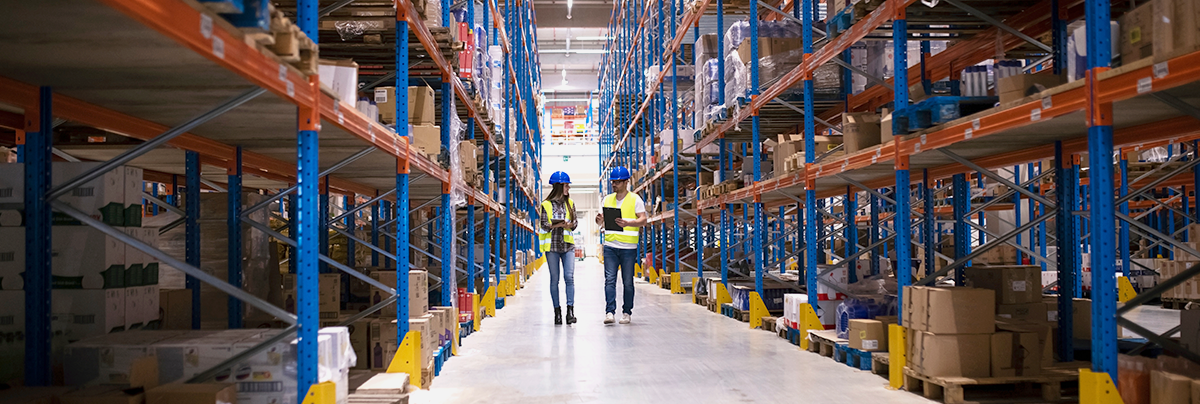Why the Design of Your Distribution Center Is Important

An ideal warehouse and distribution center work efficiently and help operations with minimal delays. While a warehouse management system can help with your warehouse operating procedure, the layout of your distribution center can affect how fast and smooth your process goes.
As such, your distribution center design plays a crucial role in your business operations. Here are some reasons you should consider the layout of your operations, from manufacturing to shipping.
Your Layout Affects Your Distribution Center Type
There are four types of distribution centers:
- Consolidation Distribution Centers: Distribution centers that receive various materials from one or more suppliers and then consolidate the items to send to customers
- Break-bulk Distribution Centers: Buying bulk from a supplier and then selling smaller pieces of that order to customers
- Cross-dock Distribution Centers: Distribution centers with no inventory and serve as a place to redistribute products to customers
- Order Assembly Distribution Centers: Either a combination of the other three types and an added mixing or order assembly to create an entirely new product to be shipped to customers
By carefully designing the layout of your distribution center, you can make the entire process smoother so that supplies go in and out with minimal delays.
Ensures Your Functions Are Well-Defined
The function of a distribution center is for inbound and outbound shipments. With the right distribution center design, you can ensure all the physical activity within the warehouse is done systematically and smoothly. It means that when an item arrives in the warehouse, there’s a visible downstream inventory control to help you and your team track where it should go.
On the one hand, you have the inbound function of your warehouse. It is where items are received, unpacked, inspected, and stored. On the other hand, your outbound areas should be focused on order fulfillment and shipping. Many businesses put a lot of emphasis on their distribution center design to ensure orders are consolidated and packed with maximum efficiency.
Maximize Your Space
Larger warehouses are becoming a growing trend for businesses, especially given the e-commerce boom within the last few years. Since it’s expected for e-commerce to continue to grow, many are open to expanding or exploring vertical expansion. However, not all small businesses may have the resources to consider expanding, so the next best option is to maximize your space.
Considering everything about your distribution center design – from your inventory storage to the shipping area layout – can help you find the most efficient route for your team to take before shipping your products to your customers. The more you can do in less time and with less movement, the lower your labor costs.
Create A One-Way Flow
Depending on your distribution center type, a one-way flow operation may be the most efficient way to maximize your space and reduce the time it takes to handle your products. It doesn’t necessarily have to be a straight line down your warehouse, but the concept is that all your products go in one direction only.
However, consider factors like the size of the aisles, your team’s safety, and overall performance. The whole point of the one-way flow system is to maximize efficiency and performance. If there are issues because of your space constraints, you might need to adjust as necessary.
Minimize Material Handling
Human error can cause several kinks in a process. While not everything can or should have to be automated, minimizing material handling can make your operations more efficient while reducing the risk of product damage and incorrect order fulfillment.
A good rule of thumb is to limit the number of times your team touches your products to three to five times. Any more than that, your distribution center design may need to be more optimized.
Avoid A Domino Effect for Dock Space
Your dock is essential for inbound materials and outbound packages to your customers. It might seem like a lot of empty space, but the length and depth are necessary for safe and proper receiving, inspection, quality assurance, and more before leading to the next stage of your process.
One symptom of a poorly designed inbound dock or shipping area layout is when your dock space is empty, but you have congested aisles and pallets all over your warehouse. It happens when you don’t have enough dock space, and it affects the other warehouse locations.
Not only does this cause inefficiency in your warehouse, but it becomes a safety hazard leaving things all over your distribution center. If this is the case with your warehouse right now, it’s a sign that it might be time to rethink your design.
Make Space for Equipment Crucial to Your Business
Plenty of equipment can help you consolidate, pack, label, and take all the necessary steps before sending your products to your customers. However, an issue with the poor design is that you might not have the space for it, or your warehouse isn’t designed to be efficient even with equipment.
When designing your distribution center, you should consider the function of equipment and how it can help your production become more efficient. For instance, if you place your packing equipment in one area of the room, how many hands will you need to touch a package to get from the machine before being ready for outbound shipping? Will your team need to take additional steps to take it to the next step, or will the next part of the assembly be right next to it?
Find Strategic Packaging Solutions with Envoy Solutions
The design of your distribution center can determine how fast and efficient your operations can be. When done correctly, you can reduce labor costs and the risks of errors that can affect your operations or customer satisfaction. With the right design and equipment to prepare your products, you can achieve a well-designed distribution center that boosts your business’s bottom line.
At Envoy Solutions, we are your partner for finding commercial packaging solutions. Let’s make your processes more efficient with the right equipment to speed up your business demands. Contact us today to discuss the types of packaging solutions you need.

